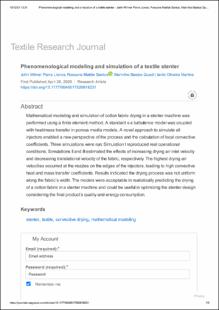Phenomenological modeling and simulation of a textile stenter
Artículo de revista
2020-04-28
Textile Research Journal
Washintong D.C , Estados Unidos
Mathematical modeling and simulation of cotton fabric drying in a stenter machine was performed using a finite element method. A standard κ-ɛ turbulence model was coupled with heat/mass transfer in porous media models. A novel approach to simulate all injectors enabled a new perspective of the process and the calculation of local convective coefficients. Three simulations were run: Simulation I reproduced real operational conditions; Simulations II and III estimated the effects of increasing drying air inlet velocity and decreasing translational velocity of the fabric, respectively. The highest drying air velocities occurred at the nozzles on the edges of the injectors, leading to high convective heat and mass transfer coefficients. Results indicated the drying process was not uniform along the fabric’s width. The models were acceptable in realistically predicting the drying of a cotton fabric in a stenter machine and could be useful in optimizing the stenter design considering the final product’s quality and energy consumption.
Descripción:
Phenomenological modeling and simulation of a textile stenter.pdf
Título: Phenomenological modeling and simulation of a textile stenter.pdf
Tamaño: 252.4Kb
 PDF
PDF
 LEER EN FLIP
LEER EN FLIP
Título: Phenomenological modeling and simulation of a textile stenter.pdf
Tamaño: 252.4Kb
 PDF
PDF
 LEER EN FLIP
LEER EN FLIP
















